Yoga and Martial Arts: The Ultimate Training Combo for Martial Arts Schools
Dhwani Shah
October 9, 2025
‧
8 min read
Did you, like me, grow up watching Jackie Chan and Bruce Lee movies? Devouring the adrenaline of power-packed punches, gravity-defying kicks and all-round action? Then came the movie The Karate Kid (which I, of course, went to watch for the dramatic martial arts sequences and my favorite, Jackie Chan, in a different type of role). It wasn't until the quiet scene—the woman on a temple ledge, a cobra reflecting her movements—till I started thinking about the calm behind the combat, the tranquility behind the technique, the awareness behind the action. The control, the precision, the focus, the breathwork.
It almost felt like a form of meditation, and reminded me of a yogi. Relaxed yet alert. Gentle yet powerful. Mind and body in complete sync. Which makes me think: Aren't martial arts poses and kata a lot like yoga asanas and sequences? Held in the moment, an ode to the body and mind’s capabilities.
Yoga and martial arts aren’t opposite ends of the spectrum, they’re allies. The ancient Indian practice of yoga is a great cross-training activity for martial artists to build flexibility, balance, strength, agility, and most importantly, mental discipline. Both emphasize the values of respect, humility and mindfulness.
As a martial arts trainer or academy owner, I’m sure you wish to elevate your students’ training experience and performance in the best possible way. And incorporating yoga into your martial arts classes is one of the most effective ways to do so.
So how, you may think, do the serene practices of yoga and meditation intersect with the explosive world of martial arts? Read on to discover the benefits of yoga for martial arts, targeted yoga poses and breathing exercises for martial arts training, and how to incorporate this powerful combination into your martial arts academy.
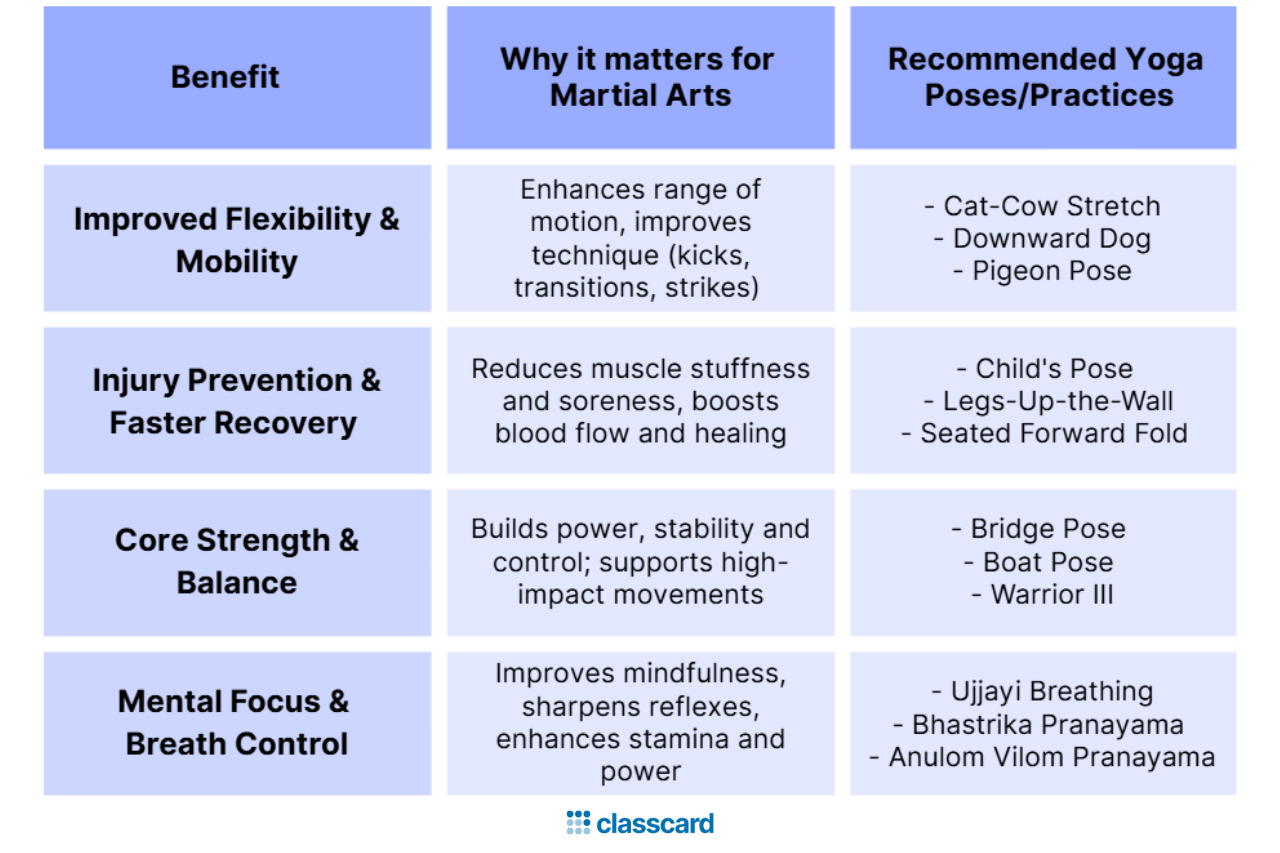
Yoga poses involve stretching your muscles to release stiffness and improve flexibility, an important aspect of martial arts practice. According to WebMD, “In one study, people improved their flexibility by up to 35% after only 8 weeks of yoga”
Increased flexibility and range of motion aid martial artists to execute techniques with precision, be it the quick motions in Brazilian Jiu Jitsu, the high kicks in Taekwondo or the fluid transitions between movements in a karate Kata.
The cat-cow stretch involves moving the spine from a rounded position to an arched position, in sync with inhalations and exhalations. It improves spinal flexibility and mobility and relieves back pain.
How to do the Cat-Cow Stretch: Sit on all fours, placing your wrists under your shoulders and your knees under your hips. As you inhale deeply, curve your lower back and tilt your head and pelvis up like a cow. As you exhale, round your spine, bring your abdomen in, and drop your head and pelvis down like a cat. Repeat 5-10 times.
This is a beginner-friendly pose which involves stretching the whole body on all fours, like a dog does. It is both a transitional and a resting pose which forms a part of almost all yoga classes and many yoga sequences, including the sun salutation sequence. It lengthens the hamstrings and calf muscles and strengthens the shoulders and arms, which improves striking power.
How to do the Downward Dog Pose: Start on all fours, with your hands slightly in front of your shoulders and knees under your hips. Press your hands to the mat, tuck your toes under and lift your knees off the floor. Keep your legs as straight as you can and push your hips upward to form an inverted “V” shape. Keep your spine long, press your heels gently toward the floor, and relax your head between your arms. Hold for 5–7 breaths.
The pigeon pose is a deep hip-opening position that stretches the hips, groin, and thighs and supports mobility and flexibility in the lower body, ideal for martial artists who engage in kicking and grappling. It further releases stored tension and lengthens the spine, reducing the risk of injuries and strain.
How to do the Pigeon Pose: Begin in the downward-dog position. Bring your right leg forward and bend your knee to place it behind your right wrist. Slide your foot towards the opposite hand and rotate your right shin so that it’s parallel with the front of your mat.
Extend your left leg straight behind you with the top of your foot flat on the mat. Square your hips and gently lower your upper body over your front leg, either resting on your forearms or stretching fully forward, adjusting as per your comfort and flexibility. Breathe deeply and hold the pose for 5–7 breaths before switching sides.
Improved flexibility and range of motion safeguard martial art practitioners from possible injury by improving muscle elasticity and joint mobility. Stretching also alleviates soreness from intense training sessions and fights by promoting blood flow to muscles, leading to quicker recovery and a more consistent training regimen.
A child's pose is a restorative stretch that gently relaxes the muscles in the hips, thighs and ankles while relieving tension in the back and neck. This resting pose promotes deep relaxation after a long training session or between intense bouts of strenuous sparring.
How to do the Child’s Pose: Start on all fours, hands shoulder-width apart and knees hip-width apart. The top of the feet should be on the floor with the toes touching each other. Gently lower your hips back towards your heels as you extend your arms forward with the palms facing the floor and rest your forehead on the mat. Relax your shoulders and neck and take slow, deep breaths.

Legs-up-the-wall is a beginner-friendly yoga pose which inverts the body without straining the neck or head. This restorative stance relaxes the mind and improves circulation. It also alleviates tension in the legs and lower back, which martial arts practitioners often experience due to the demands of the sport.
How to do the Legs-up-the-wall Pose: Lie down on a yoga mat close to a wall with your feet on the ground, positioning your tailbone towards the base of the wall. Place your legs straight up against the wall and gently wiggle your body close to the wall so that your tailbone is against it and both your legs are vertically above your hips. Rest your hands on your belly or on either side of the floor beside you. Adjust your position so you are comfortable and relaxed.
The seated forward fold is a classic Hatha yoga pose which gives an intense stretch to the entire back of the body, increasing spine elasticity for greater agility and loosening tight hamstrings for higher kicks. It also improves joint mobility and relieves stress and anxiety.
How to practice the Seated Forward Fold: Sit up straight with your legs together straight in front, toes pointing towards you. Inhale and raise both arms towards the ceiling, parallel to your ears, spine lengthened. Exhale and bend forward at your hips, spine erect, and reach with your hands towards your toes. Bring your nose towards your knees. Hold your toes, or alternatively, your ankles or shin. Breathe deeply as you hold the position for around 20 seconds.
A strong core is the centre of many movements in martial arts and is crucial for generating the power required for actions like punching, grappling and kicking. Core strength also helps maintain balance and stability, aiding better absorption of impact and making it difficult for the opponent to knock you off balance.
Yoga is not just about flexibility, it too requires core strength. Many yoga asanas require holding the position and maintaining balance, naturally engaging the core muscles in the abs, back, and hips. This core activation in turn improves stability, overall strength and athletic performance in your martial arts practice.
The bridge pose is a beginner friendly backbend that strengthens core muscles to improve posture and balance. It relieves tension in the back.
How to do the Bridge Pose: Start by lying down on your back with your knees bent, shoulder-width apart, and feet flat against the floor. Place your hands down by your side, palms facing the floor. Now, inhale and push your hips up toward the ceiling while your head, neck and shoulders remain down. Hold the position for around 5 breaths and exhale as you bring your hips back to the ground.
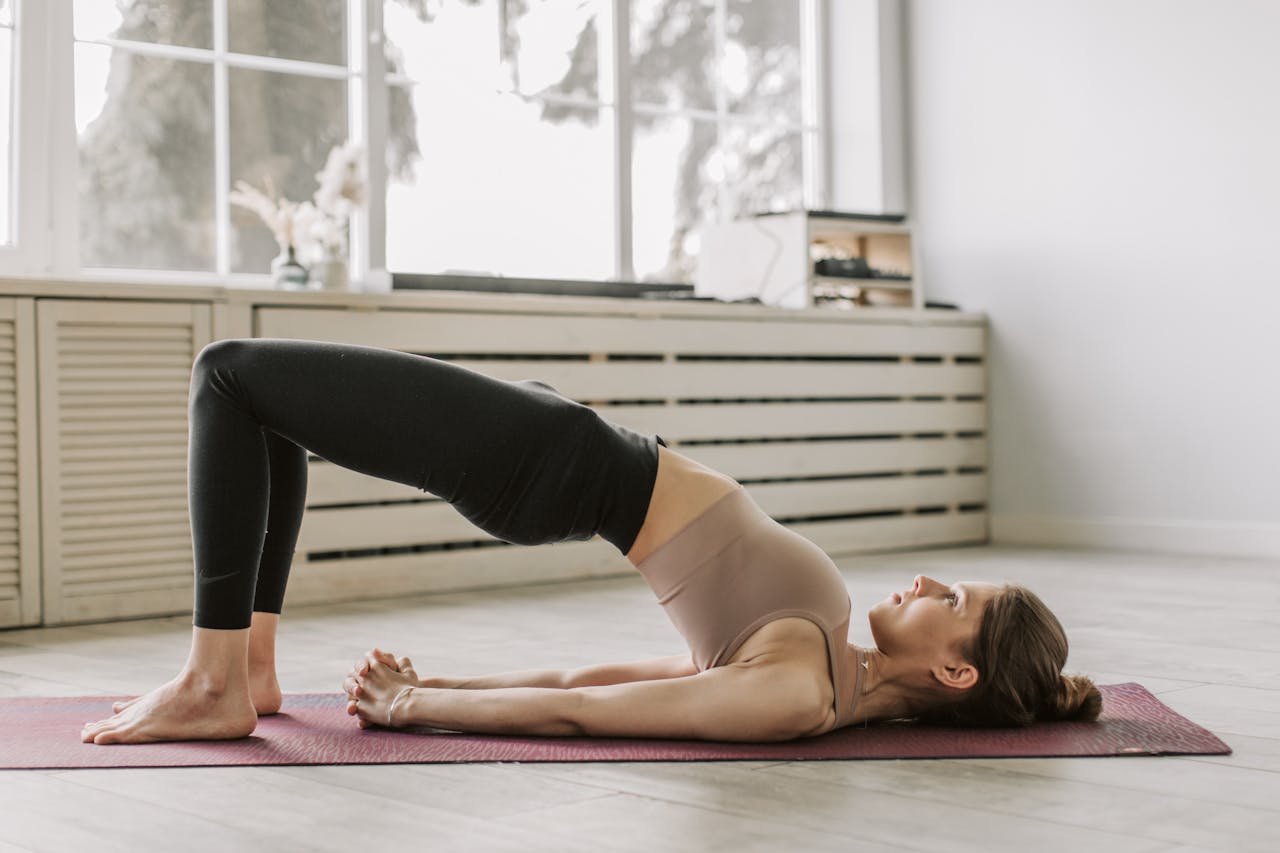
This dynamic, seated pose requires you to balance your body on the sitting bones and tail bones, resembling the shape of a boat. It strengthens the core, improves balance and stability and aids digestion.
How to do the Boat Pose: Sit on the floor with your back straight and knees slightly bent. Engaging your back muscles, lean slightly back and lift your feet up to a 45 degree angle, keeping your knees bent. Slowly, straighten your legs and reach your arms forward, parallel to the floor, with palms facing each other. Engage your core and balance on your tailbone. Keep your chest open and pull your belly button toward your spine. Hold this position for 3-5 steady breaths.
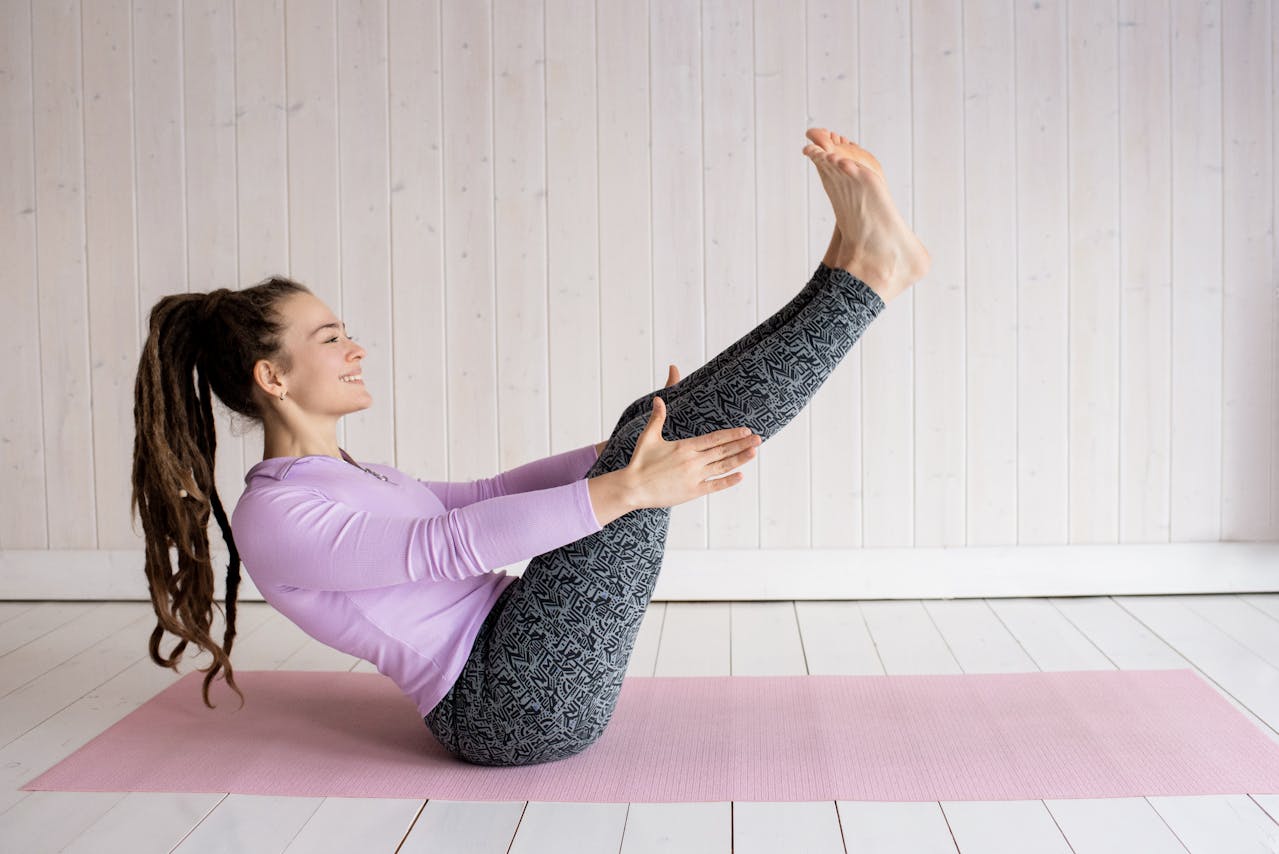
This advanced yoga pose is centered around balancing the body on one leg, while extending the other leg and the torso to create a ‘T’ shape. It strengthens the core, legs, ankles, shoulders and back. Additionally, it improves coordination and balance and sharpens focus.
How to perform the Warrior III Pose: Start straight with the feet hip-width apart, spine stretched and arms extended to the ceiling. Keep one foot grounded and firm. Lift your other leg back behind you and stretch your arms and upper body forward, so that your leg, arms and body are parallel to the ground. Hold your gaze toward the floor. Hold the position for a few breaths and repeat with the other leg.
Pranayama is the yogic practice of breath regulation which seeks to promote relaxation, reduce stress and improve mental focus and clarity. Yoga asanas synchronize breathwork with movement to cultivate a deep mind-body connection.
Mindfulness and martial arts are deeply connected too. Mental clarity and composure are essentials when engaging in a fight, for better decision making and sharper reflexes under pressure. Moreover, breath control improves lung capacity resulting in improved stamina and endurance during training sessions and sparring. Lastly, the right breathing techniques, in conjunction with body movements, can generate great power enhancing the effectiveness of strikes and blocks.
This breathing technique involves constricting the back of your throat as you inhale and exhale to create a soft, oceanic sound. Ujjayi breathing enhances mental focus and calms the nervous system, regulating thoughts and emotions during stressful sparring situations. Regulating the breath promotes physical and mental balance, which helps maintain rhythm in movements and sequences.
How to practice Ujjayi breathing: Inhale and exhale through your house. During each inhale and exhale, constrict the back of the throat to create a gentle sound, similar to the sounds of the ocean.
Bhastrika Pranayama is a vigorous breathing technique involving rhythmic, forceful inhalations and exhalations. It is a vitalizing pranayama that improves lung capacity and energizes and purifies the body, improves mental clarity and increases body awareness.
How to practice Bhastrika Pranayama: Sit in vajrasana (kneel and sit back on your heels). Form wrists and fold your arms, placing your wrists next to your shoulders. As you inhale, raise your arms up and open your fists. Exhale with force, bring your arms back down next to your shoulder and close your fists. Repeat for 10-20 rounds.
Anulom Vilom is a yogic technique of controlled breathing which aims to balance the flow of energy in the body. It entails alternating the breath between the right and left nostrils.
How to do Anulom Vilom: Sit cross-legged with your back straight, or in any comfortable meditative position. Fold the index and middle finger of the right palm inwards so that the thumb, ring finger and last finger are free and extended. Use the thumb to close the right nostril as you deeply inhale through the left. Now, close the left nostril with your ring finger and release your thumb from over the right. Exhale through the open nostril. Now, inhale through the right nostril. Again, close the right nostril with your thumb, release the ring finger from the left nostril and exhale from it. Repeat the process, alternating nostrils.
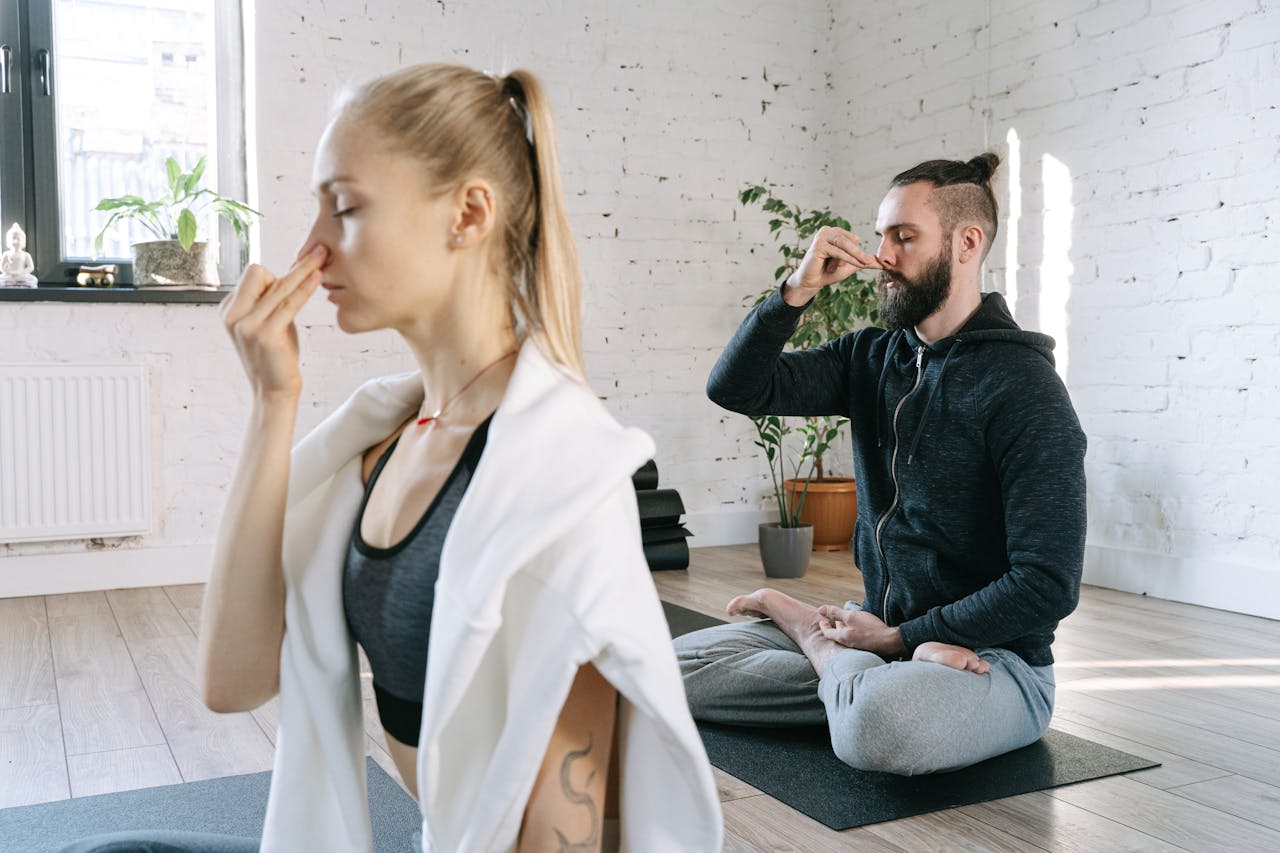
The convergence of yoga and martial arts holds immense potential to elevate your students’ training and transform their martial arts journey. But integrating yoga into your martial arts school doesn't need a complete shift of focus or change of curriculum. You can start small and gradually expand as your students experience the benefits.
Here are some practical ways to introduce yoga for martial arts in your dojo:
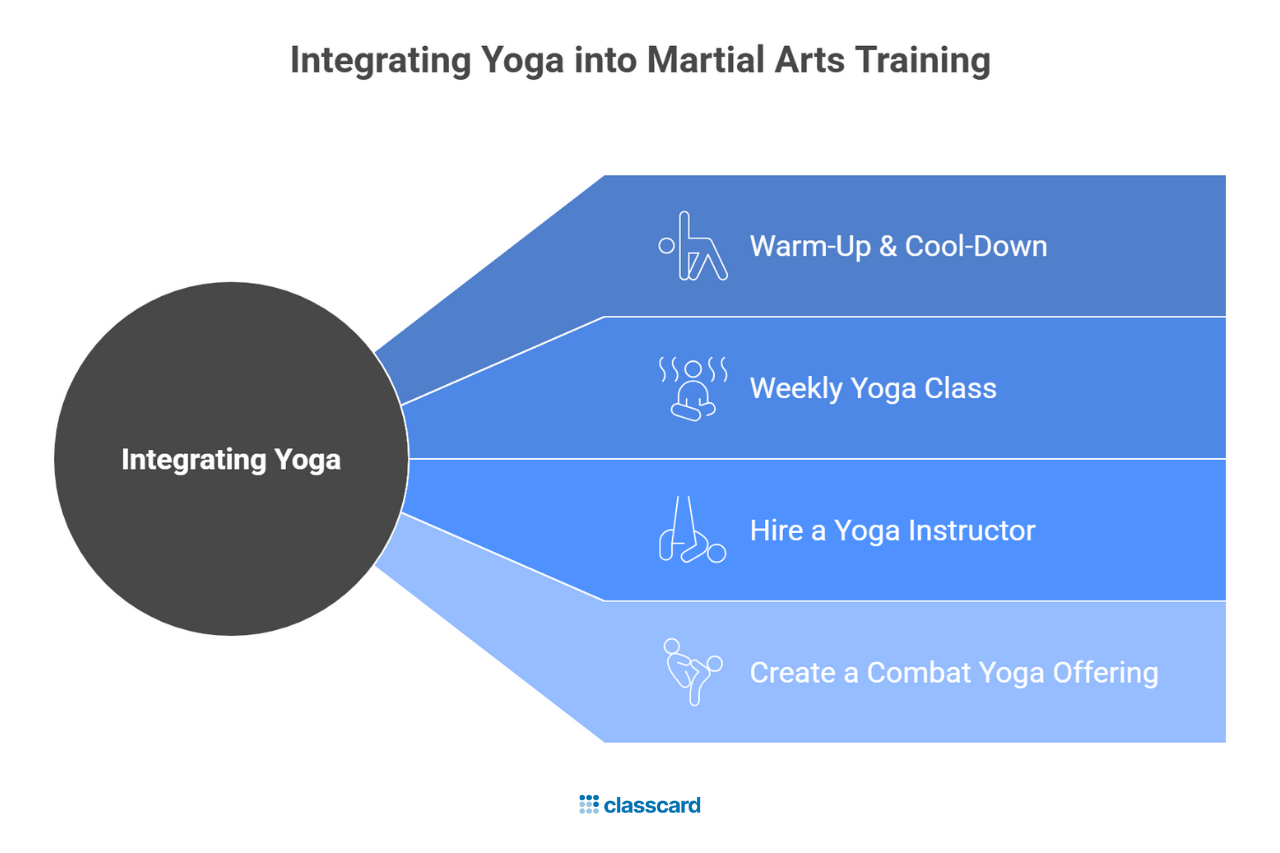
You can begin by simply adding 5 to 10 minutes of basic stretching as a warm-up and cool-down practice into every class. Before every class, start with gentle poses like the Cat-Cow Stretch, Downward Dog and other yoga-based stretches to activate and loosen muscles and joints for training. After the session, wind down with restorative positions like the Child’s Pose, Savasana and calming pranayamas to promote relaxation and recovery.
Include a dedicated yoga class as a part of your offerings, catering to the specific martial arts disciplines students have enrolled in. You could even host a common guided yoga session each week, open to students across different disciplines, with rotating weekly focuses such as Flexibility and Mobility in Week 1, Core Strength and Stability in Week 2, Breath Regulation in Week 3 and so on. This also adds variety to the training routine, keeping students engaged and motivated.
You could partner with an experienced yoga instructor to conduct weekly or monthly workshops and cross-discipline sessions over and above your regular offerings. These special community classes could be open to non-members and non-students to showcase your studio and programs to potential clients.
Combat yoga is a dynamic form of yoga that combines traditional yogic elements with the principles of martial arts to improve flexibility, stability, strength, and stress management and in turn, elevate overall performance for martial artists. Consider designing a specialized combat yoga program as a branded offering to attract signups and students interested in cross-training, wellness, or trying something new. It’s also a great way to differentiate your academy from others and expand your reach.
Whether you run an academy teaching karate, judo, muay thai or taekwondo, whether you’re teaching eager beginners or seasoned black belts, adding yoga to your martial arts training program is a proven way to help your students’ reach their full potential and become better, more complete martial artists.
However, running a martial arts school is not easy. Beyond the kicks and strikes lie countless hours of behind-the-scenes work: scheduling classes, tracking attendance and student progress, collecting fees, handling bookings, and the list goes on. So if adding yoga to your already packed routine feels like biting more than you can chew, we understand. But that’s exactly where Classcard comes in.
Our feature-rich and easy-to-use martial arts school management software takes care of all the administrative load, from class scheduling, booking and automated communication to attendance and payment tracking and much more, so you can focus on what you do best: training the next generation of disciplined, focused, and skilled martial artists. So if you’re ready to simplify your operations and elevate your academy, book a free demo today.